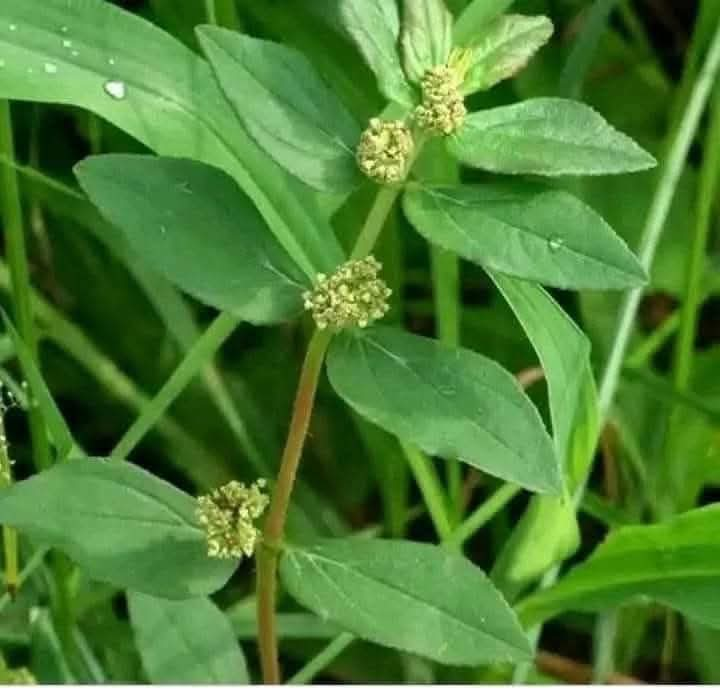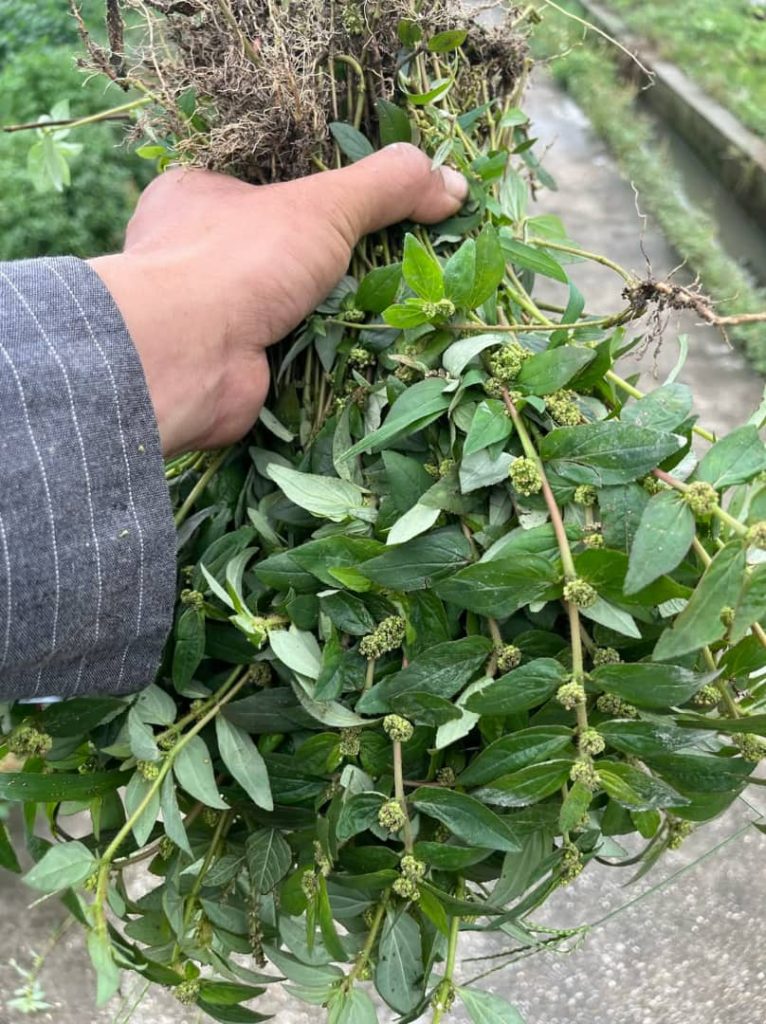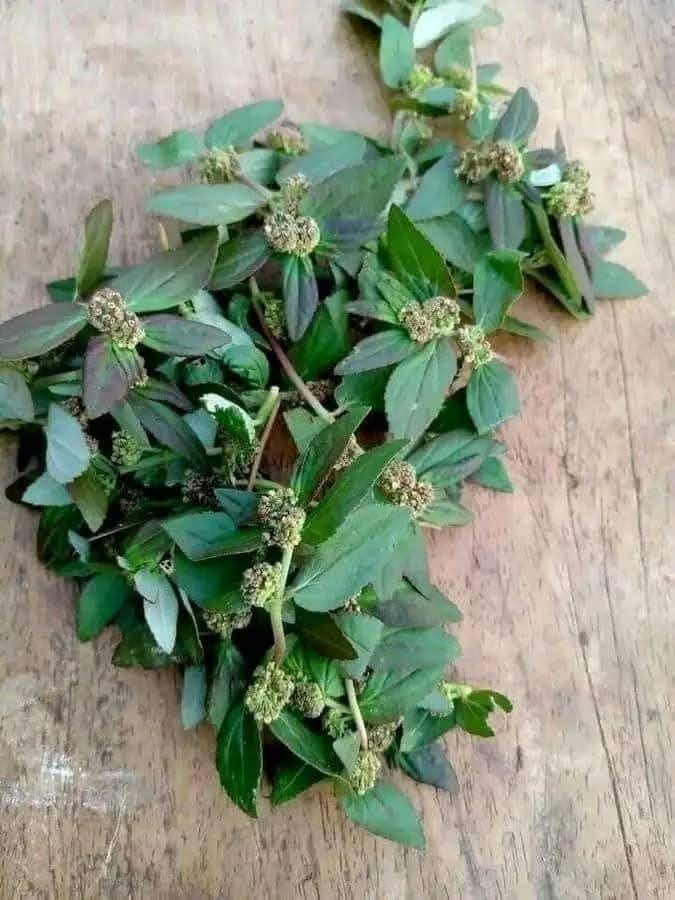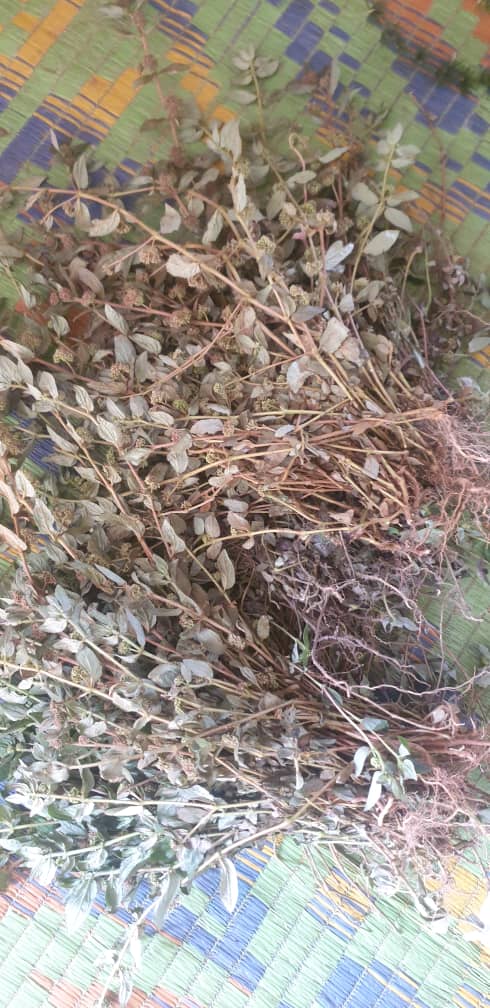
Euphorbia hirta, commonly known as asthma weed or garden spurge, is a fast-growing herbaceous plant from the Euphorbiaceae family. It is widely found in tropical and subtropical regions, thriving in open grasslands, roadsides, and waste areas.
Botanical Description:
- Growth Habit: A small, annual herb or weed with a spreading or ascending growth pattern.
- Stem: Slender, reddish, hairy, and sometimes branched at the base.
- Leaves: Small, opposite, oblong to lanceolate, with a serrated margin and a reddish or purplish tinge.
- Flowers: Tiny, clustered in dense, axillary cymes, pale green to reddish.
- Fruits: Small capsules containing minute, brown seeds.
Medicinal Uses:
Euphorbia hirta has been traditionally used in herbal medicine for:
- Treating respiratory issues like asthma and bronchitis.
- As an anti-inflammatory and antibacterial agent.
- Managing diarrhea and dysentery.
- Healing wounds and skin infections.
Other Uses:
- Often used in traditional beverages and herbal teas.
- Sometimes utilized as a forage plant for livestock.
1. Botanical Classification
- Kingdom: Plantae
- Phylum: Tracheophyta
- Class: Magnoliopsida
- Order: Malpighiales
- Family: Euphorbiaceae
- Genus: Euphorbia
- Species: Euphorbia hirta
2. Morphological Characteristics
- Habit: Herbaceous, annual weed
- Stem: Slender, reddish, hairy, often branched
- Leaves: Small, oblong to lanceolate, opposite arrangement, serrated edges
- Flowers: Tiny, greenish to reddish, arranged in dense axillary cymes
- Fruits: Small, trilocular capsules with minute seeds
3. Habitat & Distribution
- Habitat: Found in grasslands, roadsides, agricultural fields, and disturbed areas
- Geographical Distribution: Widely spread in tropical and subtropical regions of Asia, Africa, and the Americas
4. Chemical Composition
- Active Compounds:
- Flavonoids (quercetin, kaempferol)
- Alkaloids
- Saponins
- Tannins
- Terpenoids
- Polyphenols
- Potential Pharmacological Properties: Antibacterial, antifungal, antioxidant, anti-inflammatory, analgesic
5. Medicinal & Traditional Uses
- Respiratory System:
- Used to treat asthma, bronchitis, and colds
- Gastrointestinal System:
- Used for diarrhea, dysentery, and intestinal parasites
- Skin & Wound Healing:
- Applied to wounds, boils, and rashes
- Anti-inflammatory & Analgesic:
- Reduces swelling and pain
- Lactation Aid:
- Traditionally used to promote milk production in breastfeeding women
6. Toxicity & Side Effects
- May cause skin irritation in some individuals
- Large doses could be toxic to humans and animals
- Should be used with caution, especially during pregnancy
7. Agricultural & Ecological Significance
- Considered a weed in crop fields and gardens
- Can help in soil stabilization due to its spreading nature
- Attracts beneficial insects
Local Treatments Using Euphorbia hirta

In traditional medicine, Euphorbia hirta (asthma weed) is widely used for various ailments. Below are some common local treatments and preparation methods:
1. Respiratory Issues (Asthma, Cough, Bronchitis)
- Preparation:
- Boil a handful of dried Euphorbia hirta leaves and stems in 2 cups of water for 10–15 minutes.
- Strain and drink as a herbal tea 2–3 times a day.
- Alternative Method:
- Fresh leaves can be chewed with honey to relieve cough.
2. Diarrhea & Dysentery
- Preparation:
- Crush fresh leaves and mix with warm water.
- Take one teaspoon of the extract every few hours to control diarrhea.
- Alternative Method:
- A decoction (boiled extract) of the plant can be taken twice daily.
3. Wound Healing & Skin Infections
- Preparation:
- Crush fresh leaves into a paste and apply directly to wounds, boils, or rashes.
- Can also be mixed with coconut oil for soothing effects.
- Alternative Method:
- The milky latex (sap) can be applied to minor cuts to stop bleeding.
4. Urinary Tract Infections (UTIs)
- Preparation:
- Boil fresh or dried leaves in water and drink 1–2 times daily.
- Alternative Use:
- Leaf extract can be mixed with sugar or honey for better taste.
5. Milk Production for Breastfeeding Mothers
- Preparation:
- Drink an infusion made from dried Euphorbia hirta leaves once a day.
- Caution:
- Should be taken in moderation and with medical advice.
6. Fever & Malaria
- Preparation:
- Boil leaves and stems in water, strain, and drink twice daily.
- Alternative Use:
- The decoction can be mixed with ginger or lemon for added benefits.
7. Anti-Inflammatory & Pain Relief (Arthritis, Muscle Pain, Headache)
- Preparation:
- Make a warm compress using boiled leaves and apply to painful areas.
- Alternative Method:
- Drink the herbal tea for internal inflammation relief.
8. Contraceptive & Menstrual Regulation
- Preparation:
- Traditionally used as a natural contraceptive and to regulate menstruation by drinking a strong decoction of the leaves.
- Caution:
- Should not be used excessively as it may cause side effects.
Precautions & Side Effects
- Always use in moderation; excessive intake can be toxic.
- Pregnant women should avoid it unless advised by a healthcare professional.
- Some people may experience skin irritation from the plant’s latex.
Preparation Methods for Euphorbia hirta
There are different ways to prepare Euphorbia hirta for medicinal use, depending on the condition being treated. Below are the common methods:
1. Herbal Tea (Infusion or Decoction)

Used for asthma, cough, diarrhea, fever, UTI, and lactation
Ingredients:
- 1 handful of fresh or dried Euphorbia hirta leaves and stems
- 2 cups of water
Preparation:
- Wash the leaves and stems thoroughly.
- Boil the water and add the plant material.
- Let it simmer for 10–15 minutes.
- Strain and let it cool.
- Drink 1–2 times daily.
💡 Tip: You can add honey, lemon, or ginger for better taste and added benefits.
2. Fresh Leaf Juice (Cold Extract)
Used for diarrhea, dysentery, urinary infections, and wounds
Ingredients:
- Fresh Euphorbia hirta leaves (a handful)
- ½ cup of clean water
Preparation:
- Crush or blend the fresh leaves with water.
- Strain the mixture using a clean cloth.
- Drink 1–2 teaspoons up to twice a day.
💡 Tip: You can mix it with honey or warm water for easier consumption.
3. Poultice (External Use)
Used for wound healing, skin infections, boils, rashes, and inflammation
Ingredients:
- Fresh leaves
- Mortar and pestle (or a blender)
Preparation:
- Crush the fresh leaves into a paste.
- Apply directly to wounds, boils, or inflamed skin.
- Cover with a clean cloth or bandage if needed.
- Reapply 2–3 times daily until healed.
💡 Tip: Mix with coconut oil for a soothing effect.
4. Milky Latex (Sap Application)
Used for small wounds, insect bites, and skin irritations
Preparation:
- Break a stem or leaf to collect the white milky sap.
- Apply a small amount directly to the affected area.
- Leave it for a few minutes before washing off.
💡 Caution: Avoid contact with the eyes and open wounds, as the latex may cause irritation.
5. Dried Powder (For Storage & Capsules)
Used for long-term storage and making herbal supplements
Preparation:
- Collect fresh leaves and stems.
- Wash and dry them under shade to retain medicinal properties.
- Once fully dried, grind into a fine powder using a mortar, grinder, or blender.
- Store in an airtight container for up to 6 months.
💡 Usage:
- Mix ½ teaspoon in warm water or tea and drink once daily.
- Can be put into empty capsules for easy consumption.
6. Herbal Oil (Infused Oil for Skin & Massage)
Used for skin care, inflammation, and pain relief
Ingredients:
- 1 cup of dried Euphorbia hirta leaves
- 1 cup of coconut or olive oil
Preparation:
- Crush dried leaves and place them in a jar.
- Pour warm coconut or olive oil over the leaves.
- Let it sit for 1–2 weeks, shaking occasionally.
- Strain the oil and store it in a bottle.
- Apply to the skin for pain relief or wound healing.
Precautions & Storage Tips
✔ Always wash the plant thoroughly before use.
✔ Use in moderation to avoid toxicity.
✔ Store dried leaves, powders, or oils in cool, dark places.
✔ Consult a healthcare provider before long-term use, especially for pregnant women.
Country Availability of Euphorbia hirta

Euphorbia hirta is widely distributed in tropical and subtropical regions around the world. It grows in open fields, roadsides, and waste areas, often as a common weed. Below is its availability by region:
1. Asia
✅ Widely Available
- India – Used in Ayurvedic and traditional medicine.
- China – Found in southern regions, used in herbal treatments.
- Indonesia, Philippines, Malaysia, Thailand, Vietnam – Grows abundantly and is used in folk medicine.
- Sri Lanka, Pakistan, Bangladesh, Nepal – Common in grasslands and agricultural fields.
2. Africa
✅ Widely Available
- Found across West, East, Central, and Southern Africa, including:
- Nigeria, Ghana, Kenya, Uganda, Tanzania, South Africa, Ethiopia
- Used in traditional African medicine for respiratory issues and infections.
3. North & South America
✅ Present but Less Common in Some Areas
- South America:
- Brazil, Colombia, Argentina, Peru, Venezuela, Mexico – Found in tropical regions and used in indigenous medicine.
- North America:
- United States: Found in warm regions like Florida, Texas, and California.
- Caribbean: Common in Jamaica, Haiti, Dominican Republic.
Leave a Reply